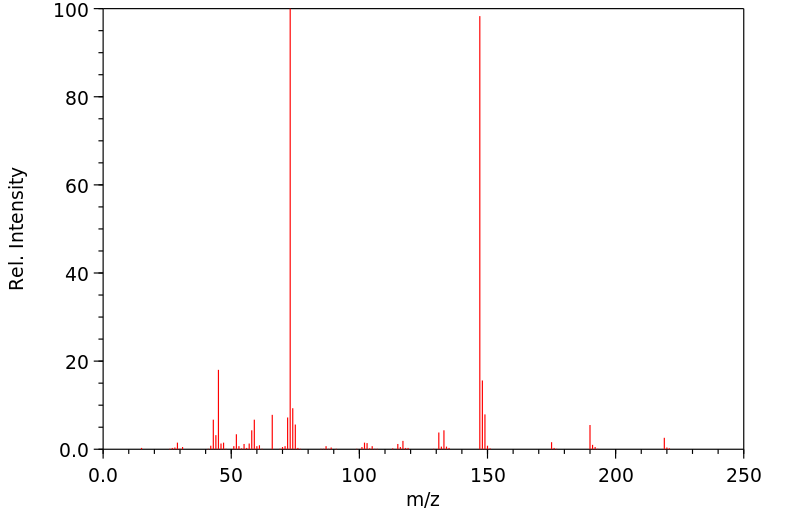bis(trimethylsilyl) oxalate | 18294-04-7
中文名称
——
中文别名
——
英文名称
bis(trimethylsilyl) oxalate
英文别名
ethanedioic acid bis(trimethylsilyl) ester
CAS
18294-04-7
化学式
C8H18O4Si2
mdl
——
分子量
234.4
InChiKey
DDCDOSJHFOGNRO-UHFFFAOYSA-N
BEILSTEIN
——
EINECS
——
-
物化性质
-
计算性质
-
ADMET
-
安全信息
-
SDS
-
制备方法与用途
-
上下游信息
-
文献信息
-
表征谱图
-
同类化合物
-
相关功能分类
-
相关结构分类
物化性质
-
沸点:96 °C(Press: 10 Torr)
-
密度:0.980±0.06 g/cm3(Predicted)
-
保留指数:1124;1111;1125;1116;1119;1116;1116;1114;1100;1138.3;1114
计算性质
-
辛醇/水分配系数(LogP):1.74
-
重原子数:14
-
可旋转键数:5
-
环数:0.0
-
sp3杂化的碳原子比例:0.75
-
拓扑面积:52.6
-
氢给体数:0
-
氢受体数:4
安全信息
-
海关编码:2931900090
SDS
反应信息
-
作为反应物:描述:参考文献:名称:Electrolytic salts for lithium batteries摘要:提供适用于锂电池电解质的正硼酸盐以及制备电解质盐的方法。这些电解质盐具有以下化学式之一(I)。在这个化学式中,阴离子正硼酸基团被两个双齿螯合基团Y1和Y2包围。某些首选的螯合基团是二元酸残基,最好是草酰基、马来酰基和琥珀酰基,二磺酸残基,磺基乙酸残基和卤素取代的烷基。这些盐在非水溶剂和聚合物凝胶中溶解,是锂电池在电化学设备中的有用组分。公开号:US20040034253A1
-
作为产物:描述:参考文献:名称:KEARNEY, P. C.;RUTH, J. M.;ZENG, Q.;MAZZOCCHI, P., J. AGR. AND FOOD CHEM., 1985, 33, N 5, 953-957摘要:DOI:
-
作为试剂:描述:2,6-Dichlor-3,5-dimethyl-3,5-diaza-2,6-diphosphaheptan-4-on 在 bis(trimethylsilyl) oxalate 作用下, 以 二氯甲烷 为溶剂, 以85%的产率得到1,2,3,4-Tetramethyl-2-oxo-2λ5-[1,4,2,3]diazadiphospholidin-5-one参考文献:名称:Vogt, Roland; Schmutzler, Reinhard, Zeitschrift fur Naturforschung, B: Chemical Sciences, 1989, vol. 44, # 6, p. 690 - 698摘要:DOI:
文献信息
-
Partition coefficients of ketones, phenols, aliphatic and aromatic acids, and esters in n-hexane/nitromethane作者:Urszula Kotowska、Valery IsidorovDOI:10.2478/s11532-011-0060-4日期:2011.10.1in sample preparation and in countercurrent and liquid-liquid chromatographic separations. Partition coefficients are widely used in toxicology, environmental, and analytical chemistry. The K hn determination procedure for the n -hexane/nitromethane system was optimized and partition coefficients for 99 ketones, esters and trimethylsilyl derivatives of phenols, aliphatic and aromatic acids were determined
-
LiMOB, an Unsymmetrical Nonaromatic Orthoborate Salt for Nonaqueous Solution Electrochemical Applications作者:Wu Xu、Alan J. Shusterman、Robert Marzke、C. Austen AngellDOI:10.1149/1.1651528日期:——acetonitrile, dimethyl carbonate, and propylene carbonate, but has moderate solubility in γ-butyrolactone (GBL) and N,N-dimethylformamide (DMF), and high solubility in dimethyl sulfoxide (DMSO). The 0.5 M solutions of LiMOB in GBL, DMSO, and DMF show high conductivities (5.0 X 10 -3 S cm -1 , 5.1 × 10 -3 S cm -1 , and 11.8 X 10 -3 S cm -1 at 25°C, respectively) relative to most 0.5 M nonaqueous solutions. Even描述了成功的原硼酸锂盐双(草酸根)硼酸锂 (LiBOB) 的不对称版本的合成、表征、离子电导率、电化学稳定性和锂离子传输数。盐,锂(丙二酸草酸)硼酸盐 (LiMOB),在高达 273°C 的温度下是热稳定的。难溶于1,2-二甲氧基乙烷、四氢呋喃、乙腈、碳酸二甲酯、碳酸丙烯酯等常用有机溶剂,但在γ-丁内酯(GBL)和N,N-二甲基甲酰胺(DMF)中溶解度适中,高在二甲基亚砜 (DMSO) 中的溶解度。LiMOB 在 GBL、DMSO 和 DMF 中的 0.5 M 溶液显示出高电导率(5.0 X 10 -3 S cm -1 、5.1 × 10 -3 S cm -1 和 11.8 X 10 -3 S cm -1 在 25° C,分别)相对于大多数 0.5 M 非水溶液。即使是 0.08 M LiMOB-PC 溶液的室温电导率也接近 10 -3 S cm -1 。LiMOB 溶液的电导率接近 LiBOB
-
Chloride-Free Method to Synthesise New Ionic Liquids with Mixed Borate Anions作者:Christian Schreiner、Marius Amereller、Heiner J. GoresDOI:10.1002/chem.200802243日期:2009.2.23Chloride avoided! A new chloride‐free method to synthesise ionic liquids (ILs) with mixed borate anions, starting from tetrafluoroborate compounds, has been developed and a number of examples including some new ILs are presented (see scheme; [CAT]+=cation). It is widely applicable and allows access to mixed borates with various types of ligands in a straightforward manner.
-
一种一步法合成二氟草酸硼酸钠的方法
-
硅基酯类化合物制备方法、硅基酯类化合物、包含其的电解液及二次电池
表征谱图
-
氢谱1HNMR
-
质谱MS
-
碳谱13CNMR
-
红外IR
-
拉曼Raman
-
峰位数据
-
峰位匹配
-
表征信息
同类化合物
(2-溴乙氧基)-特丁基二甲基硅烷
鲸蜡基聚二甲基硅氧烷
骨化醇杂质DCP
马沙骨化醇中间体
马来酸双(三甲硅烷)酯
顺式-二氯二(二甲基硒醚)铂(II)
顺-N-(1-(2-乙氧基乙基)-3-甲基-4-哌啶基)-N-苯基苯酰胺
降钙素杂质13
降冰片烯基乙基三甲氧基硅烷
降冰片烯基乙基-POSS
间-氨基苯基三甲氧基硅烷
镓,二(1,1-二甲基乙基)甲基-
镁,氯[[二甲基(1-甲基乙氧基)甲硅烷基]甲基]-
锑,二溴三丁基-
铷,[三(三甲基甲硅烷基)甲基]-
铂(0)-1,3-二乙烯-1,1,3,3-四甲基二硅氧烷
钾(4-{[二甲基(2-甲基-2-丙基)硅烷基]氧基}-1-丁炔-1-基)(三氟)硼酸酯(1-)
金刚烷基乙基三氯硅烷
酰氧基丙基双封头
达格列净杂质
辛醛,8-[[(1,1-二甲基乙基)二甲基甲硅烷基]氧代]-
辛甲基-1,4-二氧杂-2,3,5,6-四硅杂环己烷
辛基铵甲烷砷酸盐
辛基衍生化硅胶(C8)ZORBAX?LP100/40C8
辛基硅三醇
辛基甲基二乙氧基硅烷
辛基三甲氧基硅烷
辛基三氯硅烷
辛基(三苯基)硅烷
辛乙基三硅氧烷
路易氏剂-3
路易氏剂-2
路易士剂
试剂Cyanomethyl[3-(trimethoxysilyl)propyl]trithiocarbonate
试剂3-[Tris(trimethylsiloxy)silyl]propylvinylcarbamate
试剂3-(Trimethoxysilyl)propylvinylcarbamate
试剂2-(Trimethylsilyl)cyclopent-2-en-1-one
试剂11-Azidoundecyltriethoxysilane
西甲硅油杂质14
衣康酸二(三甲基硅基)酯
苯胺,4-[2-(三乙氧基甲硅烷基)乙基]-
苯磺酸,羟基-,盐,单钠聚合甲醛,1,3,5-三嗪-2,4,6-三胺和脲
苯甲醇,a-[(三苯代甲硅烷基)甲基]-
苯并磷杂硅杂英,5,10-二氢-10,10-二甲基-5-苯基-
苯基二甲基氯硅烷
苯基二甲基乙氧基硅
苯基二甲基(2'-甲氧基乙氧基)硅烷
苯基乙酰氧基三甲基硅烷
苯基三辛基硅烷
苯基三甲氧基硅烷







